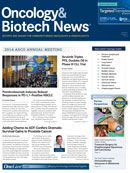Anti-PD-L1 Antibody MEDI4736 Shows Clinical Activity in NSCLC and Is Well Tolerated
The anti-PD-L1 antibody MEDI4736 has early and durable activity in patients with non–small cell lung cancer (NSCLC) of both squamous and nonsquamous histology, with higher objective response rates occurring in PD-L1–positive patients, according to results of an ongoing phase I study.
Julie R. Brahmer, MD
The anti-PD-L1 antibody MEDI4736 has early and durable activity in patients with non—small cell lung cancer (NSCLC) of both squamous and nonsquamous histology, with higher objective response rates occurring in PD-L1–positive patients, according to results of an ongoing phase I study.
MEDI4736 is well tolerated at all doses, and these preliminary data support its accelerated clinical development, noted lead investigator Julie R. Brahmer, MD, associate professor of Oncology at the Johns Hopkins Kimmel Cancer Center, who presented the findings at the 2014 ASCO Annual Meeting.
As an anti—PD-L1 antibody, MEDI4736 binds to PD-L1, allowing T-cells to recognize and kill tumor cells. It exhibits no immunogenicity that impacts pharmacokinetics or pharmacodynamics at 10 mg/kg, the dose being tested in phase III trials: of 196 patients treated with 10 mg/kg, only two showed antidrug antibodies, she said, and only 1 of 18 treated with doses other than 10 mg/ kg showed antidrug antibodies.
In the multicenter, open-label study (NCT01693562), MEDI4736 is being administered intravenously, 0.1 to 10 mg/ kg every 2 weeks to 15 mg/kg every 3 weeks, using a 3+3 dose escalation followed by expansion cohorts. The patients with NSCLC enrolled in the study were assigned to expansion cohorts by histology (squamous or nonsquamous) and line of therapy (treatment-naïve, second line, or third line plus). Retreatment was permitted for progression after 12 months of therapy.
Of the study’s 155 NSCLC patients (12 of whom had received other than the 10 mg/kg dose), 48% received three or more prior lines of systemic therapy, 17% received two prior lines, and 23% received one prior line. Nearly all (98%) had ECOG performance status of 0 or 1 (per formance status was unknown in the other 2%). Sixty percent of patients had nonsquamous histology; 40% had squamous NSCLC.
Response was assessed by RECIST criteria during the expansion phase. Of the 58 evaluable patients (at least one follow-up scan), the response rate at the data cutoff of May 18, 2014, was 16%, and the disease control rate (RECIST response plus stable disease for at least 12 weeks) was 35%. In the 10-mg/kg—dose group, there were six responses in 47 evaluable patients (13%).
“If you look at just PD-L1—positive disease, the response rate is higher, but we’re still seeing responses in patients with PD-L1–negative disease,” said Brahmer. Five of 20 evaluable patients with PD-L1–positive disease had a RECIST response, compared with 1 of 29 PD-L1–negative patients. The disease control rate was 45% (9/20) in the PD-L1–positve patients and 24% (7/29) in the PD-L1–negative patients.
“This trial requires a fresh biopsy, so we feel like we are getting a better snapshot of what the tumor is right there, though in the future we’re comparing archival tissue to fresh biopsies to see if there’s much of a difference,” noted Brahmer. “The theory is that PD-L1 expression may go down in the tumor, and we’ll be able to take a look at that and report on it in the near future.”
Seventy percent of patients at all doses experienced an adverse event (AE). Grade 3/4 AEs occurred in 39 patients, and serious AEs were reported in 36 patients. Treatmentrelated AEs of any grade occurred in 29% of patients, of which 3% were grade 3/4 and 1% serious. No treatment-related adverse events led to treatment discontinuation or death, and no colitis of any grade or grade 3/4 pulmonary toxicities were reported.
The most common any-grade AEs in patients receiving all doses of MEDI4736 were fatigue (7%), nausea (5%), vomiting (5%), arthralgia (4%), and rash (4%).
“In general, MEDI4736 has been very well tolerated,” said Brahmer. “Most of the side effects are very low grade, and most of my patients feel very well on this type of therapy.”
Going forward, the investigators will determine MEDI4736 activity in the first-, second-, and third-line settings, she said. Biomarkers that may correlate with activity are under investigation.
“Potentially, it may be combined with other things, and the question is whether to take it earlier, beyond just the metastatic stage,” Brahmer said. “A trial is about to launch in patients with stage III disease, after chemotherapy and radiation therapy, and then giving MEDI4736 afterward to try to maintain response or improve survival.”
Brahmer JR, Rizvi NA, Lutsky J, et al. Clinical activity and biomarkers of MEDI4736, an anti—PD-L1 antibody, in patients with NSCLC. J Clin Oncol. 2014;32:5s (suppl; abstr 8021).




